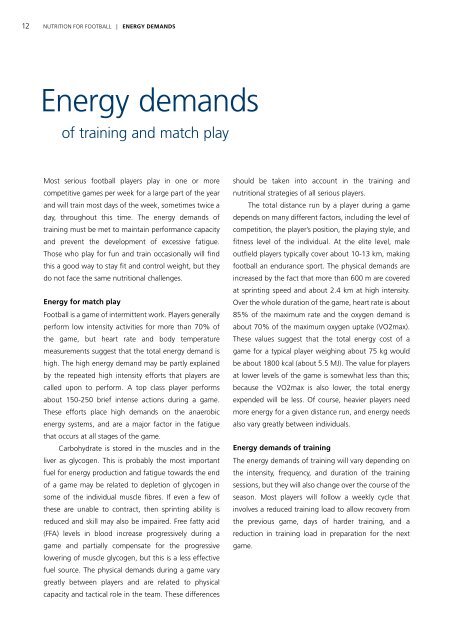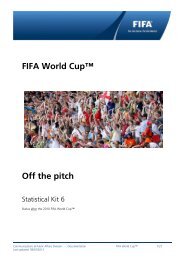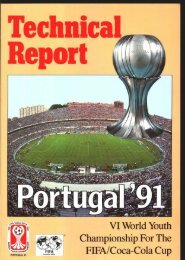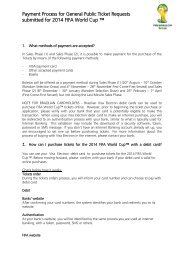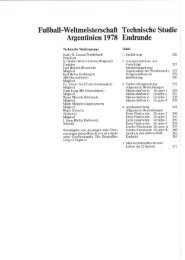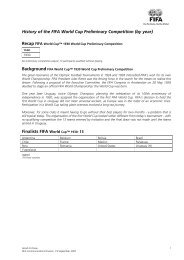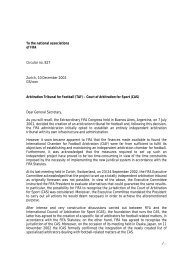Nutrition for football - FIFA.com
Nutrition for football - FIFA.com
Nutrition for football - FIFA.com
You also want an ePaper? Increase the reach of your titles
YUMPU automatically turns print PDFs into web optimized ePapers that Google loves.
12 NUTRITION FOR FOOTBALL | ENErGy dEMaNdS<br />
NUTRITION FOR FOOTBALL | ENErGy dEMaNdS 13<br />
Energy demands<br />
of training and match play<br />
Most serious <strong>football</strong> players play in one or more<br />
<strong>com</strong>petitive games per week <strong>for</strong> a large part of the year<br />
and will train most days of the week, sometimes twice a<br />
day, throughout this time. The energy demands of<br />
training must be met to maintain per<strong>for</strong>mance capacity<br />
and prevent the development of excessive fatigue.<br />
Those who play <strong>for</strong> fun and train occasionally will find<br />
this a good way to stay fit and control weight, but they<br />
do not face the same nutritional challenges.<br />
Energy <strong>for</strong> match play<br />
Football is a game of intermittent work. Players generally<br />
per<strong>for</strong>m low intensity activities <strong>for</strong> more than 70% of<br />
the game, but heart rate and body temperature<br />
measurements suggest that the total energy demand is<br />
high. The high energy demand may be partly explained<br />
by the repeated high intensity ef<strong>for</strong>ts that players are<br />
called upon to per<strong>for</strong>m. A top class player per<strong>for</strong>ms<br />
about 150-250 brief intense actions during a game.<br />
These ef<strong>for</strong>ts place high demands on the anaerobic<br />
energy systems, and are a major factor in the fatigue<br />
that occurs at all stages of the game.<br />
Carbohydrate is stored in the muscles and in the<br />
liver as glycogen. This is probably the most important<br />
fuel <strong>for</strong> energy production and fatigue towards the end<br />
of a game may be related to depletion of glycogen in<br />
some of the individual muscle fibres. If even a few of<br />
these are unable to contract, then sprinting ability is<br />
reduced and skill may also be impaired. Free fatty acid<br />
(FFA) levels in blood increase progressively during a<br />
game and partially <strong>com</strong>pensate <strong>for</strong> the progressive<br />
lowering of muscle glycogen, but this is a less effective<br />
fuel source. The physical demands during a game vary<br />
greatly between players and are related to physical<br />
capacity and tactical role in the team. These differences<br />
should be taken into account in the training and<br />
nutritional strategies of all serious players.<br />
The total distance run by a player during a game<br />
depends on many different factors, including the level of<br />
<strong>com</strong>petition, the player’s position, the playing style, and<br />
fitness level of the individual. At the elite level, male<br />
outfield players typically cover about 10-13 km, making<br />
<strong>football</strong> an endurance sport. The physical demands are<br />
increased by the fact that more than 600 m are covered<br />
at sprinting speed and about 2.4 km at high intensity.<br />
Over the whole duration of the game, heart rate is about<br />
85% of the maximum rate and the oxygen demand is<br />
about 70% of the maximum oxygen uptake (VO2max).<br />
These values suggest that the total energy cost of a<br />
game <strong>for</strong> a typical player weighing about 75 kg would<br />
be about 1800 kcal (about 5.5 MJ). The value <strong>for</strong> players<br />
at lower levels of the game is somewhat less than this;<br />
because the VO2max is also lower, the total energy<br />
expended will be less. Of course, heavier players need<br />
more energy <strong>for</strong> a given distance run, and energy needs<br />
also vary greatly between individuals.<br />
Energy demands of training<br />
The energy demands of training will vary depending on<br />
the intensity, frequency, and duration of the training<br />
sessions, but they will also change over the course of the<br />
season. Most players will follow a weekly cycle that<br />
involves a reduced training load to allow recovery from<br />
the previous game, days of harder training, and a<br />
reduction in training load in preparation <strong>for</strong> the next<br />
game.<br />
In pre-season, the training load is usually at its<br />
greatest as players strive to reach full fitness <strong>for</strong> the<br />
opening games of the season. Energy demands in a<br />
training session focused on fitness may exceed those of<br />
a hard game. In sessions where the emphasis is on<br />
recovery and regeneration or on skill, the energy cost<br />
will be much less.<br />
Energy needs<br />
The foods we eat and the fluids we drink provide <strong>for</strong> the<br />
immediate energy needs of the body as well as<br />
influencing body energy stores. Energy stores play a<br />
number of important roles related to exercise<br />
per<strong>for</strong>mance, since they contribute to<br />
• Size and physique (e.g. body fat and muscle mass)<br />
• function (e.g. muscle mass)<br />
• fuel <strong>for</strong> exercise (e.g. muscle and liver carbohydrate<br />
stores)<br />
The energy needed <strong>for</strong> training and match play must be<br />
added to the energy required <strong>for</strong> normal daily activities.<br />
This will depend on physical activity at work and on<br />
other lifestyle factors.<br />
How much food a player needs will depend largely<br />
on the total energy needs, and there is no simple <strong>for</strong>mula<br />
to predict this. Energy needs depend not only on the<br />
demands of training and match play, but also on<br />
activities outside the game. For those who train<br />
infrequently, or where training sessions are short or easy,<br />
the energy demands will not be high. Similarly, energy<br />
needs are lower during periods of inactivity such as the<br />
off-season or while a player is injured, and players<br />
should adapt their food intake accordingly.<br />
How much food a player<br />
needs will depend largely on<br />
the total energy needs.


